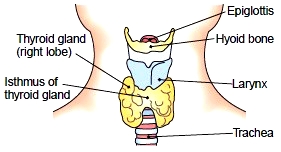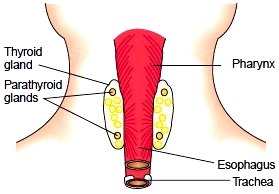The Thyroid Gland
The thyroid, located in the neck, is the largest of the endocrine glands (Fig. 8-4). The thyroid has two roughly oval lateral lobes on either side of the larynx (voice box) connected by a narrow band called an isthmus. A connective tissue capsule encloses the entire gland.
Hormones of the Thyroid Gland The thyroid produces two hormones that regulate metabolism. The principal hormone is thyroxine, which is symbolized as T4, based on the number of iodine atoms in each molecule. The other hormone, which contains three atoms of iodine, is triiodothyronine, or T3. These hormones function to increase the rate of metabolism in body cells. In particular, they increase energy metabolism and protein metabolism. Both thyroid hormones and growth hormone are needed for normal growth. The thyroid gland needs an adequate supply of iodine to produce its hormones. Iodine deficiency is rare now due to widespread availability of this mineral in iodized salt, vegetables, seafood, dairy products, and processed foods. Another hormone produced by the thyroid gland is calcitonin, which is active in calcium metabolism. Calcitonin lowers the amount of calcium circulating in the blood by promoting the deposit of calcium in bone tissue. Calcitonin works with parathyroid hormone and with vitamin D to regulate calcium metabolism.

Figure 8-4 Thyroid gland (anterior view). The two lobes and isthmus of the thyroid are shown in relation to other structures in the throat. The epiglottis is a cartilage of the larynx.
Disorders of the Thyroid Gland A goiter is an enlargement of the thyroid gland, which may or may not be associated with overproduction of hormone. A simple goiter is the uniform overgrowth of the thyroid gland, with a smooth surface appearance. An adenomatous, or nodular, goiter is an irregular-appearing goiter accompanied by tumor formation. For various reasons, the thyroid gland may become either underactive or overactive. Underactivity of the thyroid, known as hypothyroidism, shows up as two characteristic states related to age:
* Infantile hypothyroidism, also known as cretinism, is a condition resulting from hypothyroidism in infants and children. The usual cause is a failure of the thyroid gland to form during fetal development (congenital hypothyroidism). The infant suffers lack of physical growth and lack of mental development. Early and continuous treatment with replacement hormone can alter the outlook of this disease. By state law, all newborns are tested for hypothyroidism in the U.S.
* Infantile hypothyroidism, also known as cretinism, is a condition resulting from hypothyroidism in infants and children. The usual cause is a failure of the thyroid gland to form during fetal development (congenital hypothyroidism). The infant suffers lack of physical growth and lack of mental development. Early and continuous treatment with replacement hormone can alter the outlook of this disease. By state law, all newborns are tested for hypothyroidism in the U.S.
* Myxedema results from thyroid atrophy (wasting) in the adult. The patient becomes sluggish both mentally and physically and often feels cold. The hair becomes dry and the skin becomes dry and waxy. The tissues of the face swell. Because thyroid hormone can be administered orally, the patient with myxedema regains health easily, although treatment must be maintained throughout life. Hyperthyroidism is the opposite of hypothyroidism, that is, overactivity of the thyroid gland with excessive secretion of hormone. A common form of hyperthyroidism is Graves disease, which is characterized by a goiter, a strained appearance of the face, intense nervousness, weight loss, a rapid pulse, sweating, tremors, and an abnormally quick metabolism. Another characteristic symptom is protrusion (bulging) of the eyes, known as exophthalmos, which is caused by swelling of the tissue behind the eyes (Fig. 8-5). Treatment of hyperthyroidism may take the following forms:
* Suppression of hormone production with medication;
* Destruction of thyroid tissue with radioactive iodine;
* Surgical removal of part of the thyroid gland.
* Suppression of hormone production with medication;
* Destruction of thyroid tissue with radioactive iodine;
* Surgical removal of part of the thyroid gland.

Figure 8-5 Graves disease showing goiter and exophthalmos. Goiter is enlargement of the thyroid; exophthalmos is bulging of the eyes.
An exaggerated form of hyperthyroidism with a sudden onset is called a thyroid storm. Untreated, it is usually fatal, but with appropriate care, most affected people can be saved. Thyroiditis is a general term meaning inflammation of the thyroid. The cause may be infection or autoimmunity, that is, abnormal production of antibodies to the thyroid gland. Hashimoto disease is an autoimmune thyroiditis that may be hereditary and may also involve excess intake of iodine. The disease results in enlargement of the thyroid (goiter) and hypothyroidism. It is treated with thyroid hormone replacement and, in some cases, surgery.
Tests of Thyroid Function The most frequently used tests of thyroid function are blood tests that measure the uptake of radioactive iodine added to a blood sample. These very sensitive tests are used to detect abnormal thyroid function and to monitor response to drug therapy. A test for the level of thyroid-stimulating hormone (from the pituitary) is frequently done at the same time. Further testing involves giving a person oral radioactive iodine and measuring the amount and distribution of radiation that accumulates in the thyroid gland.
The four tiny parathyroid glands are embedded in the posterior capsule of the thyroid (Fig. 8-6). The secretion of these glands, parathyroid hormone (PTH), promotes calcium release from bone tissue, thus increasing the amount of calcium circulating in the bloodstream. PTH also causes the kidney to conserve calcium. Low PTH, as may be caused by removal of
Tests of Thyroid Function The most frequently used tests of thyroid function are blood tests that measure the uptake of radioactive iodine added to a blood sample. These very sensitive tests are used to detect abnormal thyroid function and to monitor response to drug therapy. A test for the level of thyroid-stimulating hormone (from the pituitary) is frequently done at the same time. Further testing involves giving a person oral radioactive iodine and measuring the amount and distribution of radiation that accumulates in the thyroid gland.
The Parathyroid Glands
The four tiny parathyroid glands are embedded in the posterior capsule of the thyroid (Fig. 8-6). The secretion of these glands, parathyroid hormone (PTH), promotes calcium release from bone tissue, thus increasing the amount of calcium circulating in the bloodstream. PTH also causes the kidney to conserve calcium. Low PTH, as may be caused by removal of
the parathyroids, results in muscle spasms known as tetany. PTH works with calcitonin from the thyroid gland to regulate calcium metabolism. These hormone levels are controlled by negative feedback based on the amount of calcium in the blood. When calcium is high, calcitonin is produced; when calcium is low, PTH is produced.

Figure 8-6 Parathyroid glands (posterior view). The four small parathyroid glands are embedded in the posterior surface of the thyroid.
Calcium Metabolism Calcium balance is required not only for the health of bones and teeth but also for the proper function of the nervous system and muscles. One other hormone is needed for calcium balance in addition to calcitonin and PTH. This is calcitriol, technically called dihydroxycholecalciferol, the active form of vitamin D. Calcitriol is produced by modification of vitamin D in the liver and then the kidney. It increases intestinal absorption of calcium to raise blood calcium levels. Calcitonin, PTH, and calcitriol work together to regulate the amount of calcium in the blood and provide calcium for bone maintenance and other functions.
Disorders of the Parathyroid Glands Inadequate production of parathyroid hormone, as a result of removal or damage to the parathyroid glands, for example, causes a series of muscle contractions involving particularly the hands and face.
Disorders of the Parathyroid Glands Inadequate production of parathyroid hormone, as a result of removal or damage to the parathyroid glands, for example, causes a series of muscle contractions involving particularly the hands and face.
These spasms are due to a low concentration of blood calcium, and the condition is called tetany. This low calcium tetany should not be confused with the infection called tetanus (lockjaw). In contrast, if there is excess production of PTH, as may happen in tumors of the parathyroid glands, calcium is removed from its normal storage place in the bones and released into the bloodstream. The loss of calcium from the bones leads to fragile bones that fracture easily. Because the kidneys ultimately excrete the calcium, the formation of kidney stones is common in such cases.
Contacts: lubopitno_bg@abv.bg www.encyclopedia.lubopitko-bg.com Corporation. All rights reserved.
DON'T FORGET - KNOWLEDGE IS EVERYTHING!